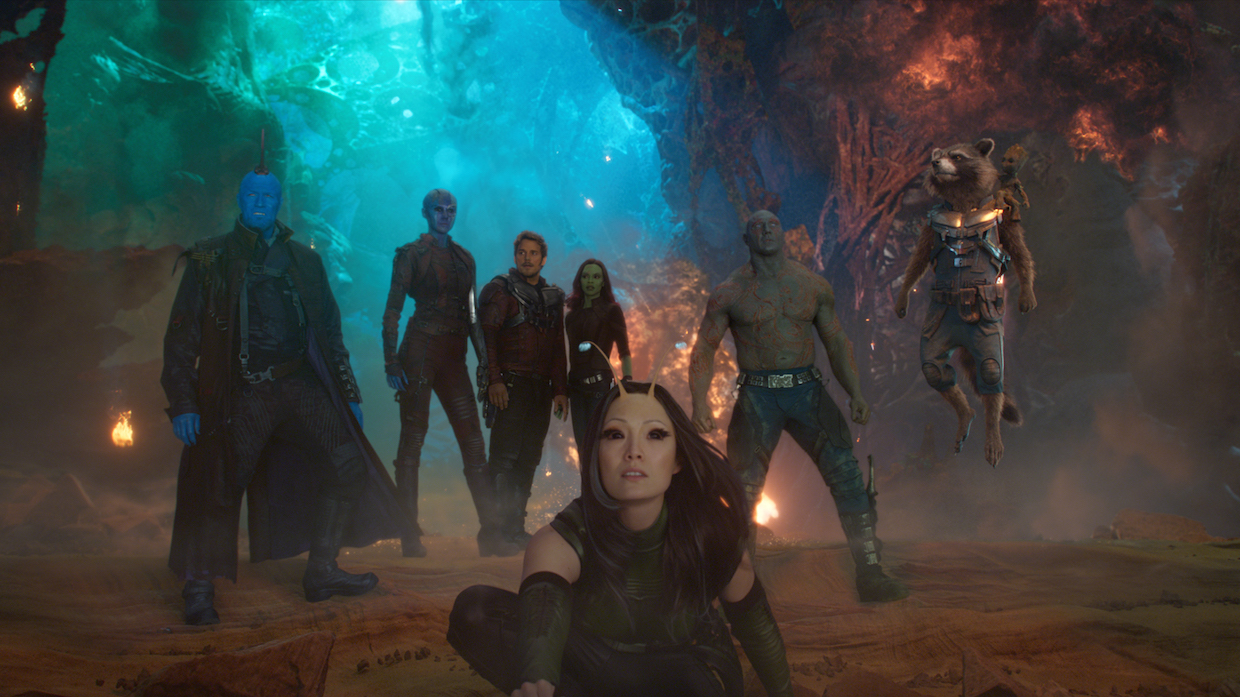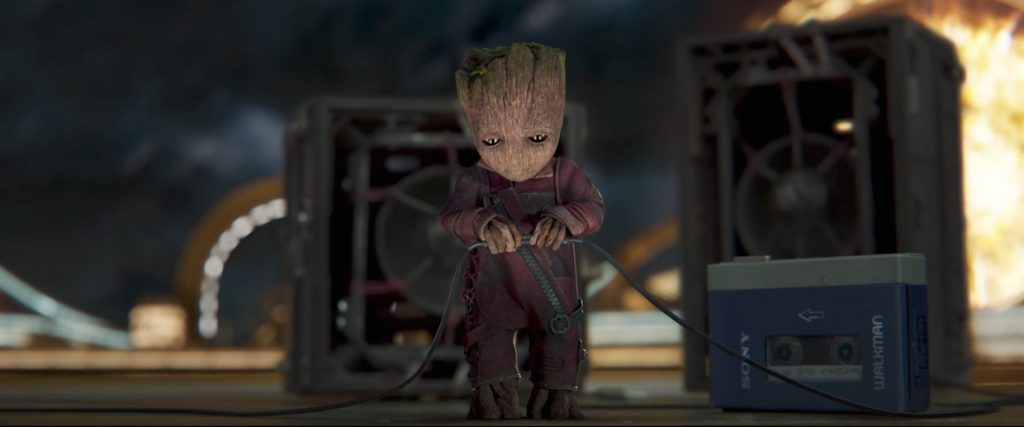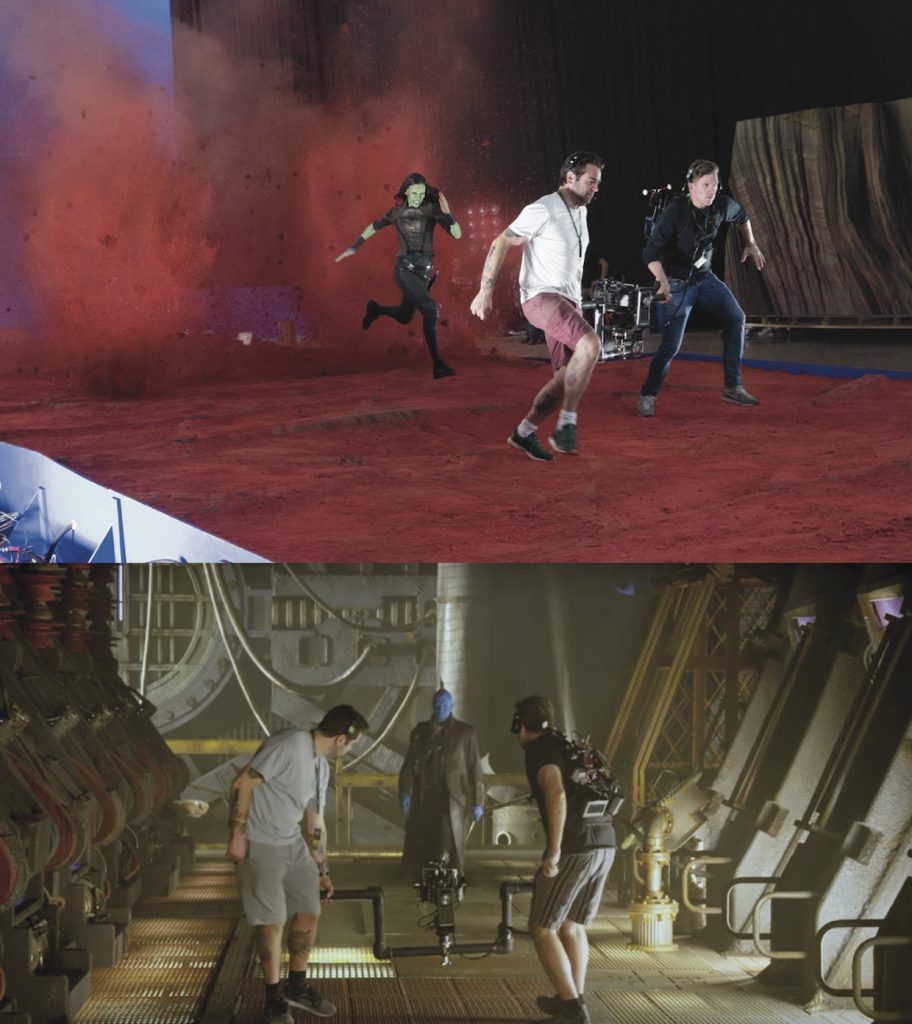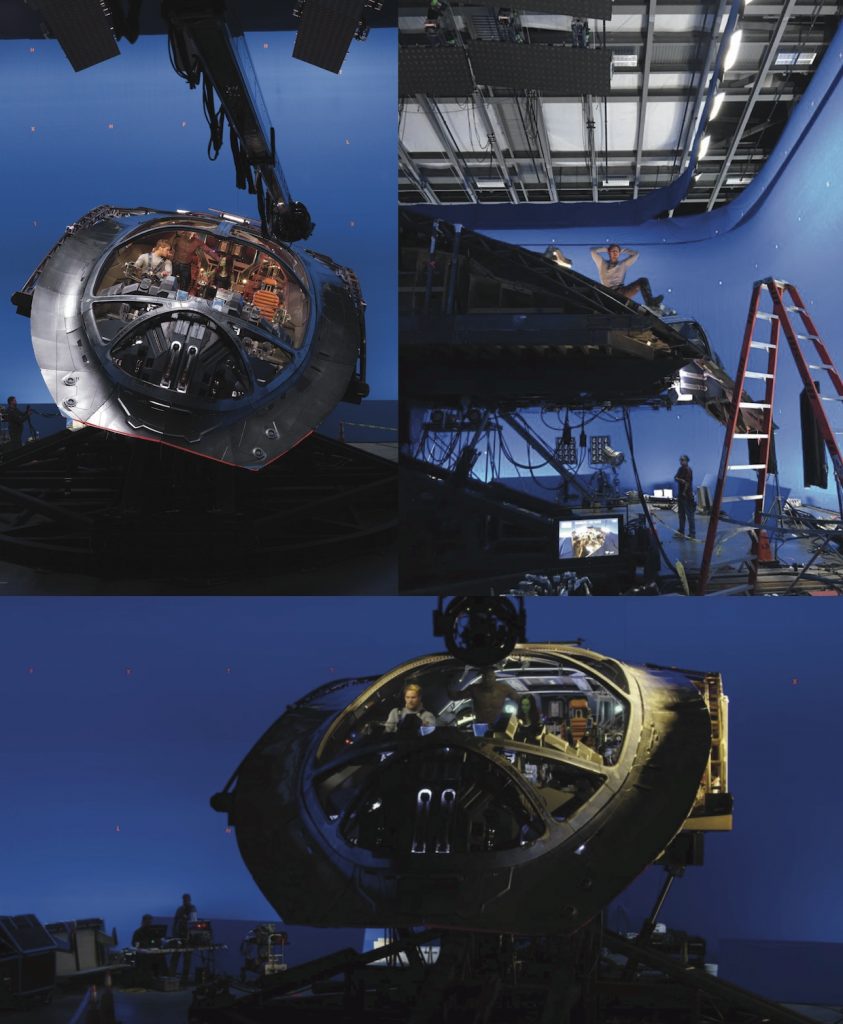 Back to selection
Back to selection
Shutter Angles
Conversations with DPs, directors and below-the-line crew by Matt Mulcahey
DP Henry Braham on Shooting Guardians of the Galaxy Vol. 2 with the First Weapon 8K Vista Vision Full Frame Camera
 Michael Rooker, Karen Gillan, Chris Pratt, Zoe Saldana, Pom Klementieff,
Dave Bautista, Bradley Cooper and Vin Diesel in Guardians of the Galaxy Vol. 2 (Photo courtesy of Marvel Studios)
Michael Rooker, Karen Gillan, Chris Pratt, Zoe Saldana, Pom Klementieff,
Dave Bautista, Bradley Cooper and Vin Diesel in Guardians of the Galaxy Vol. 2 (Photo courtesy of Marvel Studios) Compared to the rest of the Marvel Cinematic Universe, with its squeaky clean Captain America and solemn United Nations accords, the Guardians of the Galaxy — a rogues’ gallery of smugglers, thieves and assassins — are outliers. Yes, by the end of Guardians Vol. 2 the titular team are two-time galaxy savers. But for Rocket, the genetically enhanced trash panda voiced by Bradley Cooper, that just means they can jack up their rates.
Guardians’ departure from the status quo of Marvel’s ever-bloating Avengers coalition – which they will no doubt eventually be subsumed by – extends to behind the camera as well. Since Marvel abandoned 35mm around the beginning of its “Phase 2” slate, the Arri Alexa has been the studio’s camera of choice. But for Guardians Vol. 2 cinematographer Henry Braham defected to Red, becoming the first DP to shoot a feature with the company’s new Weapon 8K Vista Vision full frame camera. The British cinematographer — a veteran of VFX spectacles such as The Golden Compass and The Legend of Tarzan — spoke to Filmmaker about christening the new camera.
Filmmaker: Just so I’m understanding the specifics of the new Vista Vision camera, it’s a Weapon brain with a larger cut of the old Dragon sensor as opposed to the new Helium sensor that’s in Red’s Weapon 8K S35?
Braham: That’s correct. It was in prototype form when we were first looking at it and we worked for about three months with Red to get the camera ready to shoot a movie like Guardians.
Filmmaker: How close were you to the start of principal photography when you committed to using the camera?
Braham: We started shooting in February of 2016 and we’d made a choice about the camera by September of 2015. At the time Red only had one of them.
Filmmaker: Wait, there was literally one in existence when you pulled the trigger to shoot Guardians with it?
Braham: Yes, one prototype — and a long list of things that we needed to work on together with Red in order to make sure the camera would be suitable. But I was confident that we could get it worked out between myself, the Red guys, the visual effects team and the postproduction people at Marvel.
Filmmaker: How did you first get your hands on the prototype?
Braham: Marvel has made a lot of really fantastic and successful movies on the Alexa. That’s a system that they know very, very well and that they trust. And the Alexa 65 produces a stunning picture, there’s no two ways about it. The difficulty for me in using the Alexa 65 for Guardians was the physicality of that camera. It’s a very big and heavy camera. So I was looking for something that would deliver the same image quality as the Alexa 65, but was physically smaller. And that’s what led me to sit down with [Red Digital Cinema president] Jarred Land. I’d had a good experience shooting The Legend of Tarzan on the Red Epic Dragon and [the team at] Red had responded very well to things that I needed changed in that camera to make it suitable for that movie. So I went to see Jarred and talked to him about what I was looking to do on Guardians and he put a black box on the table in front of me and said “How about this?” And that was the very early prototype version of the 8K Vista Vision.
I took the camera in its prototype form and tested it against everything else that was a possibility for the movie, from the Alexa 65 to the Alexa XT to the Alexa Mini to the Red Dragon. [Guardians director] James Gunn immediately understood the significance of how the physicality of the [Red Vista Vision] camera could set him free in the way he could make the film. It enabled us to mount the camera in a way that was quite revolutionary. If you think about the traditional ways of mounting the camera, you can be on a dolly or a crane and both of those things have their own physicality to them. Then there’s Steadicam. I used to operate Steadicam and I think it’s a fabulous tool, but that too has a very specific voice to it. And then of course you can handhold the camera, which is great in certain situations but for both IMAX and particularly 3D you want to use handheld sparingly because over long periods of time it can be disturbing.
We ended up using a miniature stabilized head that I’d been working with in England called the Stabileye, which effectively gives you a handheld dolly. It has a really interesting feel to it because there’s a spontaneity to the way the camera moves that is different and that felt appropriate for this movie. You can be in amongst the actors and move in a way that is very difficult to do with any of the traditional methods of moving a camera. Nearly 85 percent of the movie was shot on the Stabileye and with a single camera. For a movie of this complexity to be shot as a single-camera movie is almost unheard of really.
(Above) The Stabileye in action.
Filmmaker: So you had a hand in the development of the Stabileye?
Braham: Well, I was one of the people who saw a different use for the technology. It was designed, really, for drones. The guy who designed it is called David Freeth. He has worked with stabilized heads in the film industry for a long time, but he originally came from working on gyrostablized systems for torpedoes in submarines. David had in mind one application for the Stabileye and the contribution I made to it was saying that there could be an entirely different application. That informed the development work David and his partner did with it to make it suitable for being the main camera platform on a movie like Guardians.
Filmmaker: Tell me a little bit about your on-set workflow with the Weapon 8K Vista Vision. Did you use live grading or pre-made LUTs on set?
Braham: I use Ansel Adams’s zone system, which is a very accurate way of translating what is in your head into what you see on the negative, or in this case what gets captured on the chip. So I’ve got a very precise knowledge of what it is I’m photographing and how it’s going to translate into the camera. The on-set monitor represents that to some extent, but, personally, I find on-set monitoring to be very misleading. We’re making an image primarily to be projected on a theater screen — and then of course to be distributed to other formats as well — and what you see on the on-set monitors often bears no relationship to what an image will actually look like projected on a theater screen. When I’m on set I’m also busy working with the director and in the case of Guardians operating the camera. So when I’m in the process of making the movie, I try not to be in the process of postproduction while I’m on the set.
But what I do like to do is have a laboratory set up in the editorial department and there I have a team that downloads the material and also an experienced colorist whose job it is to color time the dailies. Those graded dailies are what get projected for the director. Personally, I find it very helpful to project dailies because you can see the nuances of focus, exposure and how the camera moves on the big screen. Those things are very difficult to see on a smaller screen and if you’re just viewing your work on a smaller screen, without a doubt, you will get surprises later on.
That dailies grade provides a very good idea of how the film is intended to look at the end, which is important on a film of this scale where there are so many people that need to understand the visual intent. So a compositor that may be working in New Zealand or Toronto or London or some other disparate part of the world is working from the same basic starting point as everyone else. We used the ACES pipeline as well, so that all the decisions that were made in grading the dailies got carried all the way through to the final DI. Therefore the final DI becomes a process of making things better rather than starting from scratch.
(Above) A section of the Guardians’ ship on stage at Pinewood Atlanta Studios. The black rectangular fixtures rigged above the ship are video panels that Braham used to create interactive lighting to connect the ship to the background action.
Filmmaker: Break down down your approach to shooting Quill’s ship, which we see pictured above.
Braham: This section of Quill’s ship was actually built for the original movie and then stored. We had to have it shipped from London to Atlanta and rebuilt and then put on a gimbal, which moves the ship to create the correct momentum for the actors. The most important thing for me was creating interactive light that connected the ship to what’s happening outside. So if the ship is flying through an asteroid field, the light needs to move past and wrap around the actors in a way that connects the foreground to the background action. To light (this stage) I used a lot of video panels. The gaffer Dan Cornwall and his rigging grip Kent Baker had a really good system that allowed them to move these panels around so I could place them wherever I needed to place them. This ship goes through quite a journey in the story, from flying in sunlight to traveling in space to being hit by explosions to crashing in the forest. Those are all very different light conditions. So I wrapped video panels and other light sources around the ship so we could create really believable interactive light.
In these pictures the camera is mounted on a Technocrane so that it can move around on the outside of the ship, but when we went inside for all the dialogue we used the Stabileye. It’s so small that you can get it in there next to the actors and get angles that you wouldn’t otherwise get unless you handheld the camera.
Filmmaker: I’ve always wondered how you decide whether to use bluescreen or greenscreen. In Guardians you have to deal with characters that have skin tones that are very similar to both colors.
Braham: That’s a visual effects question really. Different visual effects supervisors will have a different view. It’s really their choice. But funnily enough, blue is a much more pleasant color to work in than green and quite frankly that has something to do with it.
Filmmaker: Let’s finish up with the opening scene of Guardians Vol. 2 – Baby Groot’s credit sequence dance number. I loved this conceit of Groot frolicking in the foreground while a large-scale action scene plays out-of-focus in the background. So Groot’s moves are actually James Gunn motion capture?
Braham: Well, the first thing I have to say is that this whole sequence is pure James Gunn and it’s brilliant for it. Yes, he did do the motion capture for the dance. He had a very clear idea in his mind of what he wanted to do and what he wanted the choreography of the camera to be. It’s very clearly described in the script. When we first discussed this [sequence] we almost thought we could physically do [the practical in-camera elements] in one shot, but then there were all sorts of complexities that came in as James developed the idea and we did previs for the scene. It’s such a complex combination of animation and live action, so we broke the thing down into different shooting elements that could be joined together.
[Production designer] Scott Chambliss designed this set and [before we shot the practical elements] we had already decided where we were going to have the sources of light and what the nature of the [digital] sky was going to be. A few of the architectural elements you see in the scene were built on stage with practical lights in them. And then in places where there were going to be further architectural elements [added via VFX] I put physical film lights there as well so that whenever any of the characters were on the set the light sources were realistic. Even in this shot you have here with Baby Groot, the light references on Baby Groot would’ve been there on set when I shot the plate and then the light sources used in post for the animation were informed by the light sources I used on the set. Chris Townsend, who’s the visual effects supervisor, was painstaking in following through on the decisions I made. He completely understands the importance of not only where the light comes from but what the nature of the light is and that’s why a lot of the visual effects are so good in the film.
Filmmaker: How many days did it take to shoot the practical elements for that sequence?
Braham: I’m guessing here, but I think it was two or three days. It was pretty quick actually, but that’s because it was so well planned. There’s a huge number of elements involved in this shot, from brilliant writing to brilliant acting through to great choreography, camera movement and really good stunt work. Creating a sequence like this is like constructing a building — all these different trades and skills come together and the result is kind of remarkable.


